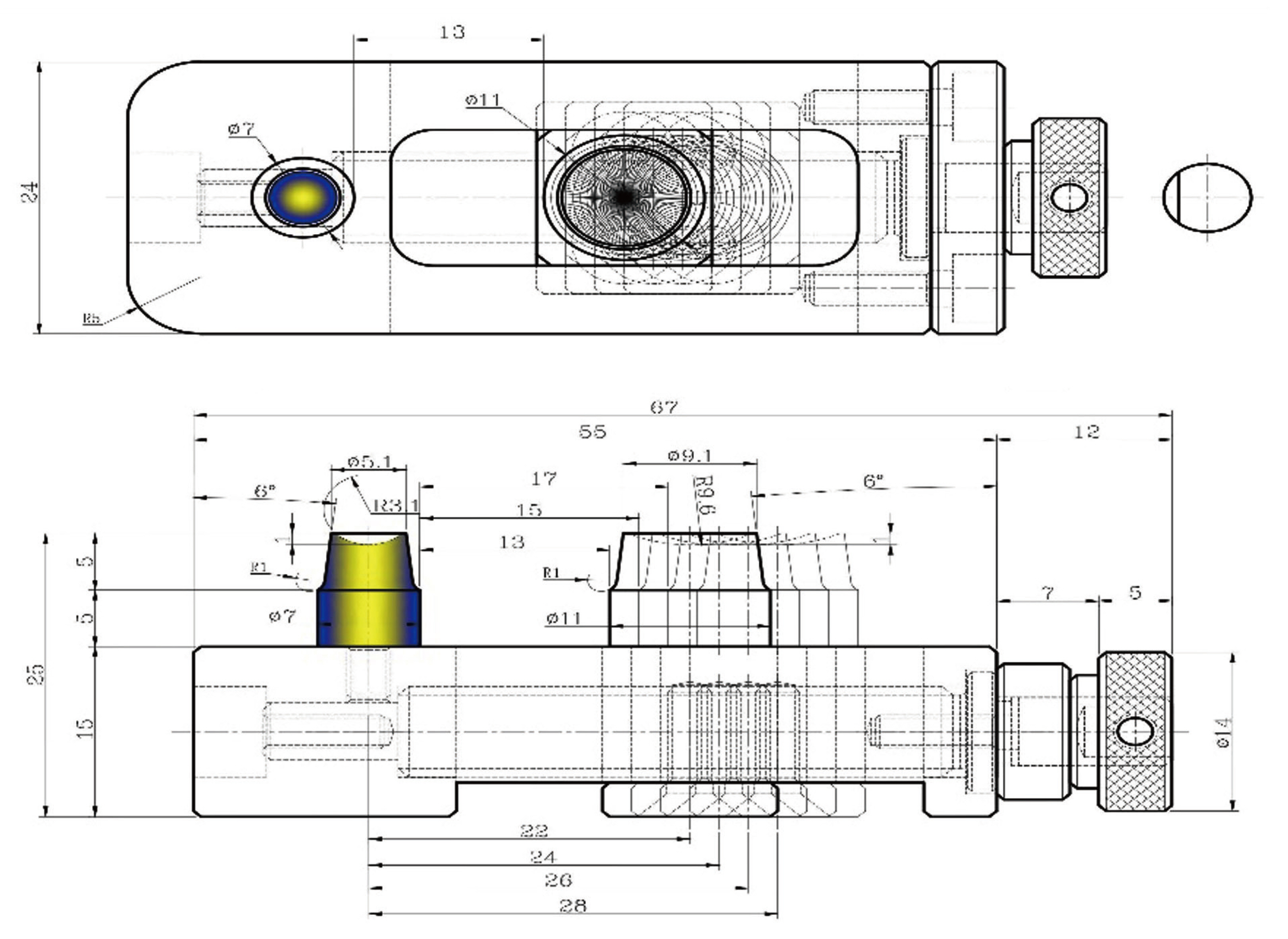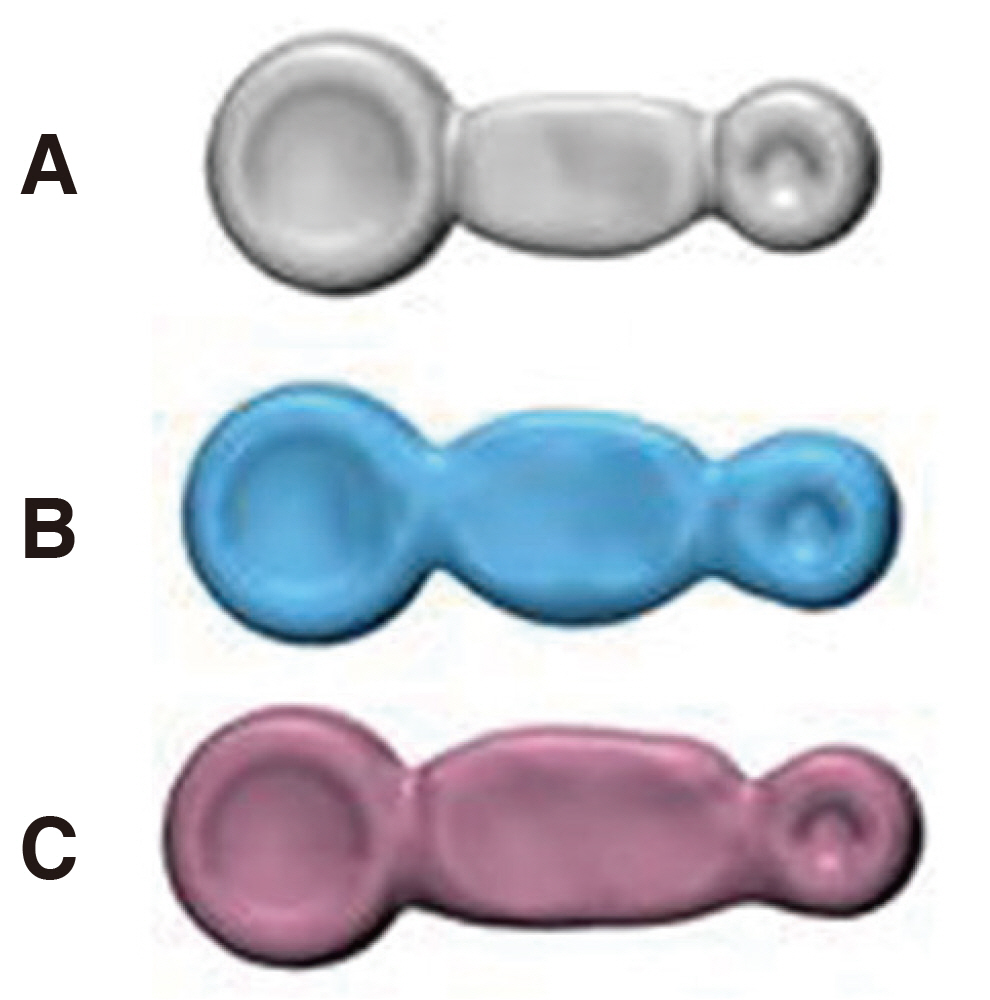J Dent Rehabil Appl Sci.
2020 Jun;36(2):61-69. 10.14368/jdras.2020.36.2.61.
Study of the fracture resistance of zirconia on posterior fixed partial dentures based on inter-abutment distance
- Affiliations
-
- 1Department of Oral Health, Graduate School of Health & Welfare, Dankook University, Cheonan, Republic of Korea
- 2Department of Prosthodontics, College of Dentistry, Dankook University, Cheonan, Republic of Korea
- KMID: 2503801
- DOI: http://doi.org/10.14368/jdras.2020.36.2.61
Abstract
- Purpose
Zirconia fixed partial dentures with mandibular 2nd premolar and 2nd molar as abutments are fabricated and then the effects of inter-abutment distance on fracture resistance of zirconia fixed partial dentures is studied.
Materials and Methods
The materials used in this study are Cameleon S zirconia block and S2 zirconia block, which are divided into CS Group and S2 Group applying different inter-abutment distance for each material, and the sintered zirconia fixed partial denture was luted to the epoxy resin die using a temporary luting cement, and then the fracture resistance was measured by placing a 6 mm diameter hardened steel ball on the occlusal surfaces of the pontics and applying pressure at a cross head speed of 1.0 mm/min on a universal testing machine with a load cell of 5.0 kN.
Results
The fracture resistance of zirconia fixed partial dentures is not significantly affected by inter-abutment distance The fracture resistance of zirconia fixed partial dentures in CS Group was significantly higher in 15 mm of inter-abutment distance than in 13 mm and 17 mm of inter-abutment distance (P < 0.05). The fracture resistance of zirconia fixed partial dentures in S2 Group was not significantly different between the three groups (P > 0.05).
Conclusion
The fracture resistance of zirconia fixed partial dentures with mandibular 2nd premolar and 2nd molar as abutments does not significantly affected by the inter-abutment distance.
Figure
Reference
-
References
1. Lee HH. 2000; Recent Dental Ceramics: Processing and Strengthening. J Korean Res Soc Dent Mater. 27:1–11.2. Ardlin BI. 2002; Transformation-toughened zirconia for dental inlays, crowns and bridges: chemical stabil-ity and effect of low-temperature aging on flexural strength and surface structure. Dent Mater. 18:590–5. DOI: 10.1016/S0109-5641(01)00095-1.3. Sobrinho LC, Cattell MJ, Glover RH, Knowles JC. 1998; Investigation of the dry and wet fatigue properties of three all-ceramic crown systems. Int J Prostho-dont. 11:255–62.4. Campbell SD, Sozio RB. 1988; Evaluation of the fit and strength of an all-ceramic fixed partial denture. J Prosthet Dent. 59:301–6. DOI: 10.1016/0022-3913(88)90177-1.5. Tinschert J, Natt G, Mautsch W, Augthun M, Spieker-mann H. 2001; Fracture resistance of lithium disilicate-, alumina-, and zirconia-based three-unit fixed par-tial dentures: a laboratory study. Int J Prosthodont. 14:231–8.6. Kohorst P, Herzog TJ, Borchers L, Stiesch-Scholz M. 2007; Load-bearing capacity of all-ceramic posterior four-unit fixed partial dentures with different zirco-nia frameworks. Eur J Oral Sci. 115:161–6. DOI: 10.1111/j.1600-0722.2007.00429.x. PMID: 17451508.7. Meyenberg KH, Lüthy H, Schärer P. 1995; Zirconia posts: a new all-ceramic concept for nonvital abut-ment teeth. J Esthet Dent. 7:73–80. DOI: 10.1111/j.1708-8240.1995.tb00565.x. PMID: 8593239.8. Wagner WC, Chu TM. 1996; Biaxial flexural strength and indentation fracture toughness of three new dental core ceramics. J Prosthet Dent. 76:140–4. DOI: 10.1016/S0022-3913(96)90297-8. PMID: 8820804.9. Keith O, Kusy RP, Whitley JQ. 1994; Zirconia brackets: an evaluation of morphology and coefficients of friction. Am J Orthod Dentofacial Orthop. 106:605–14. DOI: 10.1016/S0889-5406(94)70085-0. PMID: 7977206.10. Tinschert J, Natt G, Mautsch W, Spiekermann H, Anusavice KJ. 2001; Marginal fit of alumina- and zirconia-based fixed partial dentures produced by a CAD/CAM system. Oper Dent. 26:367–74.11. Oh W, Götzen N, Anusavice KJ. 2002; Influence of connector design on fracture probability of ceramic fixed-partial dentures. J Dent Res. 81:623–7. DOI: 10.1177/154405910208100909. PMID: 12202644.12. El-Ebrashi MK, Craig RG, Peyton FA. 1970; Experi-mental stress analysis of dental restorations. VII. structural design and stress analysis of fixed partial dentures. J Prosthet Dent. 23:177–86. DOI: 10.1016/0022-3913(70)90295-7.13. Fischer H, Weber M, Marx R. 2003; Lifetime prediction of all-ceramic bridges by computational methods. J Dent Res. 82:238–42. DOI: 10.1177/154405910308200317. PMID: 12598556.14. Mahmood DJ, Linderoth EH, Von Steyern PV, Wennerberg A. 2013; Fracture strength of all-ceramic (Y-TZP) three- and four-unit fixed dental prostheses with different connector design and production history. Swed Dent J. 37:179–87. PMID: 24620508.15. Schmitter M, Mussotter K, Rammelsberg P, Gab-bert O, Ohlmann B. 2012; Clinical performance of long-span zirconia frameworks for fixed dental prosthe-ses: 5-year results. J Oral Rehabil. 39:552–7. DOI: 10.1111/j.1365-2842.2012.02311.x. PMID: 22574689.16. Sailer I, Fehér A, Filser F, Lüthy H, Gauckler LJ, Schärer P, Franz Hämmerle CH. 2006; Prospective clinical study of zirconia posterior fixed partial dentures: 3-year follow-up. Quintessence Int. 37:685–93. PMID: 17017630.17. Guazzato M, Albakry M, Ringer SP, Swain MV. 2004; Strength, fracture toughness and microstructure of a selection of all-ceramic materials. Part II. Zirco-nia-based dental ceramics. Dent Mater. 20:449–56. DOI: 10.1016/j.dental.2003.05.002. PMID: 15081551.18. Luthardt RG, Sandkuhl O, Herold V, Walter MH. 2001; Accuracy of mechanical digitizing with a CAD/CAM system for fixed restorations. Int J Prostho-dont. 14:146–51. PMID: 11843451.19. Dahlmo KI, Andersson M, Gellerstedt M, Karls-son S. 2001; On a new method to assess the accuracy of a CAD program. Int J Prosthodont. 14:276–83.20. Moldovan O, Luthardt RG, Corcodel N, Rudolph H. 2011; Three-dimensional fit of CAD/CAM-made zirco-nia copings. Dent Mater. 27:1273–8. DOI: 10.1016/j.dental.2011.09.006. PMID: 21983002.21. Beuer F, Naumann M, Gernet W, Sorensen JA. 2009; Pre-cision of fit: zirconia three-unit fixed dental pros-theses. Clin Oral Investig. 13:343–9. DOI: 10.1007/s00784-008-0224-6. PMID: 18769946.22. Al-Amleh B, Lyons K, Swain M. 2010; Clinical trials in zir-conia: a systematic review. J Oral Rehabil. 37:641–52. DOI: 10.1111/j.1365-2842.2010.02094.x. PMID: 20406352.23. Manicone PF, Iommetti PR, Raffaelli L. 2007; An over-view of zirconia ceramics: basic properties and clinical applications. J Dent. 35:819–26. DOI: 10.1016/j.jdent.2007.07.008. PMID: 17825465.24. Tinschert J, Schulze KA, Natt G, Latzke P, Heussen N, Spiekermann H. 2008; Clinical behavior of zirconia-based fixed partial dentures made of DC-Zirkon: 3-year results. Int J Prosthodont. 21:217–22. PMID: 18548959.25. Lohbauer U, Amberger G, Quinn GD, Scherrer SS. 2010; Fractographic analysis of a dental zirconia frame-work: a case study on design issues. J Mech Behav Biomed Mater. 3:623–9. DOI: 10.1016/j.jmbbm.2010.07.004. PMID: 20826369. PMCID: PMC3086638.26. Yusuke Takuma, Syuntaro Nomoto, Toru Sato, Na-oki Sugihara. 2013; Effect of Framework Design on Frac-ture Resistance in Zirconia 4-unit All-ceramic Fixed Partial Dentures. Bull Tokyo Dent Coll. 54:149–56. DOI: 10.2209/tdcpublication.54.149. PMID: 24334628.27. Seo JY, Park IN, Lee KW. 2006; Fracture strength be-tween different connector designs of zirconia core for posterior fixed partial dentures manufactured with CAD/CAM system. J Korean Acad Prostho-dont. 44:29–39.28. Ogino Y, Nomoto S, Sato T. 2016; Effect of connector design on fracture resistance in zirconia-based fixed partial dentures for upper anterior region. Bull To-kyo Dent Coll. 57:65–74. DOI: 10.2209/tdcpublication.2015-0034. PMID: 27320295.29. Hamza TA, Attia MA, El-Hossary MM, Mosleh IE, Shokry TE, Wee AG. 2016; Flexural strength of small connector designs of zirconia-based partial fixed dental prostheses. J Prosthetic Dent. 115:224–9. DOI: 10.1016/j.prosdent.2015.06.022. PMID: 26547519.30. Bok SB. 2009. Study on the fracture resistance and reli-ability of zirconia posterior fixed partial denture. Ph. D. thesis, Dankook University.31. Seo HW. 2015. The effect of aging process on the flex-ural strength of airborne particle abraded zirconia ceramics. Master's thesis, Seoul Nat'l Univ.32. Jang KJ. 2015. Effect of infiltration with ferric oxide contaning glass on the color, microstructure and strength of zirconia. Master's thesis, Chonnam Nat'l Univ.33. Kim MC. 2014. Effects of zirconia sintering condition on flexural strength and grain size. Master's thesis, Korea Univ.34. Park JW. 2016. A Comparative Study on the fracture strength of the multi coloured monolithic zirconia restoration. Kyungpook Nat'l Univ.
- Full Text Links
- Actions
-
Cited
- CITED
-
- Close
- Share
- Similar articles
-
- Clinical performance and failures of zirconia-based fixed partial dentures: a review literature
- Fracture strength between different connector designs of zirconia core for posterior fixed partial dentures manufactured with CAD/CAM system
- Esthetic anterior restoration using 3M Lavaâ„¢ Esthetic monolithic zirconia
- Zirconia Abutment Fracture in the Anterior Region: Case Series
- The effect of reduced thickness in different regions on the fracture resistance of monolithic zirconia crowns





